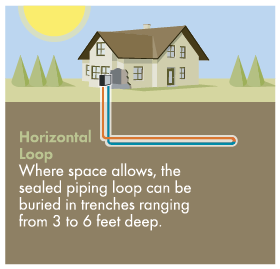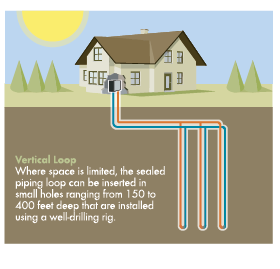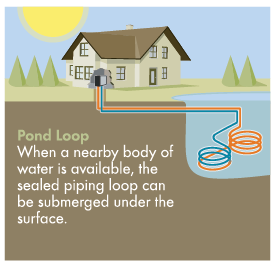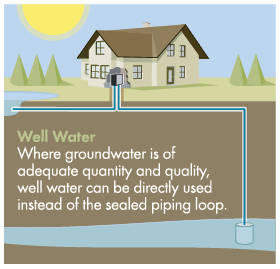Closed Loop Systems
Closed loop systems are becoming the most common type of loops. When properly installed, they are economical, efficient, and reliable. Water is circulated through a continuous buried pipe. The closed loop system is environmentally friendly because water in the loop prevents contamination to the external environment. The length of loop piping varies depending on ground temperature, thermal conductivity of the ground, soil moisture, and system design.
“Endless hot water – for the countless ways hot water improves our lives”
Horizontal
Generally the most cost-effective for small installations, horizontal closed loop works best particularly in new construction where sufficient land area is available. This type of geothermal heat installation involves burying pipe in trenches dug with backhoes or chain trenchers. Up to six pipes, usually in parallel connections, are buried in each trench, with minimum separations of a foot between pipes and ten to fifteen feet between trenches.


Vertical
Vertical closed loops are the preferred geothermal heat system for many situations. Vertical loops are used when the soil is too shallow for trenching and to minimize the disturbance to existing landscaping. For vertical closed loop systems, a U-tube (and, rarely, two U-tubes) is installed in a well drilled 100 to 400 feet deep. Because conditions in the ground may vary greatly, loop lengths can range from 130 to 300 feet per ton of heat exchange. Multiple drill holes are required for most installations, where the pipes are generally joined in parallel or series-parallel configurations.
Pond Loop System
A pond closed loop is a special kind of closed loop system. Where there is a pond or stream that is deep enough and with enough flow, closed loop coils can be placed on the pond bottom. Fluid is pumped in the same manner as a conventional closed loop ground system where conditions are suitable. The economics of this geothermal heat method are very attractive, and no aquatic system impacts have been shown.


Open Loop System
Open loop systems draw ground water from an aquifer through one well, passes through the heat pump’s heat exchanger, and is discharged to the same aquifer through a second well at a distance from the first. Generally, two to three gallons per minute per ton of capacity are necessary for effective heat exchange. Since the temperature of groundwater is nearly constant throughout the year, open loops are a popular option in areas where they are permitted.

